In this Article:
If you’re a novice shooter or an experienced one, it can be beneficial to pause and examine some insights into the cartridges we use. You might be considering expanding your firearm collection and unsure about which pistol caliber to choose, or perhaps you’re curious about the origins of a particular cartridge like the .380 ACP. Maybe you’re a reloader and wondering if that new pistol cartridge you have in mind is easy to reload. For these sorts of queries, a cartridge comparison guide is a great place to start.
One thing’s for sure – there’s no denying that pistol fans have access to an unmatched selection of handgun cartridges. There is a cartridge that will work for the task at hand, regardless of whether you are a shooter who uses a semiauto for different purposes or a hunter who favors rimmed cartridges in either a single- or double-action revolver.
The list of cartridges designed for handguns is long, but we will look at the top 11 choices. How do I know these are the top choices? Sales. These are the best-selling handgun cartridges in the U.S. in terms of numbers sold. We’ll look at where they came from, average ballistics and typical uses for each.
Here’s the common handgun caliber chart:
| Cartridge | Muzzle Energy (ft-lbs.) | Recoil Energy (ft-lbs.) |
|---|---|---|
| .22 LR | 105 | 0.67 |
| .380 ACP | 185 | 3.5 |
| .38 Spl. | 230 | 3.14 |
| .357 Mag | 620 | 10.4 |
| 9mm | 335 | 7.5 |
| .40 S&W | 400 | 10.2 |
| 10mm | 615 | 11.8 |
| .44 Spl. | 513 | 14 |
| .44 Mag | 806 | 16.9 |
| .45 ACP | 378 | 6.6 |
| .45 Colt | 459 | 10 |
As you look at the list, you see rounds named with words or letters after their numeric designation. What do they mean? Why are some in millimeters and others not? What does “Special†and “Magnum†mean? Let’s find out!
Some Definitions And Explanations
Handgun cartridges (and rifle, too, for that matter) are named in basically one of two ways.
Remember, I said “basically†– there are always exceptions.
These naming conventions include:
- Caliber, either in metric millimeters or decimal (.45, .38, .22). This generally denotes the bullet size.
- Other Descriptive Nomenclature (Special, Magnum, ACP, Long Rifle)
What do these mean? Let’s take a look.
Pistol bullet sizes are given in either millimeters or decimals. This has to do mostly with where the cartridge originated. If it’s from Europe, it will be a metric designation although there are a few metric cartridges developed in the U.S. Rounds developed in England or the U.S. will generally use a decimal designator. Both types of names simply indicate the bullet diameter, more or less. The 9mm, for example, shoots a 9mm bullet, roughly .355 inch in diameter. The 10mm and the .40 S&W both shoot the same bullet – .401 inch diameter. (A quick clarification – when I use the term “roundâ€, that means cartridge. I thought I’d better mention that up front).
Other Descriptive Nomenclature is simply an informal designation to further distinguish cartridges; here I will explain the non-numeric terms listed above:
Special/Magnum
The .38 Special and the 357 Magnum cartridges both use a .357-inch diameter bullet but the .357 Magnum round will not fit in a .38 Special’s cylinder – it is too long, on purpose. The .38 case is 1.155 in. long with the .357 case measuring at 1.285 in., a difference of .17 in. The .44 Special and Magnum cases are almost identical to their .38 counterparts in length (1.152 vs. 1.280 in). The older .38 Special is loaded to a much lower pressure than the .357 Magnum, as are the respective .44 rounds.. The more powerful magnum rounds would, most likely, blow up an older .38 or .44 Special revolver. Therefore, it is essential to avoid mixing these cartridges. Some very old .38 Special revolvers’ chambers are worn enough to allow a .357 Magnum cartridge to be inserted but I wouldn’t want to be the one to fire it.
Why .38 If It Isn’t?
Once you understand the system, it becomes clear that both the .38 Special and the .357 Magnum fire bullets with a diameter of .357 inches. Why call it a .38, you might ask. The .38 Special pre-dates the .357 by a third of a century. Before its introduction in 1898, there were several different .38 caliber cartridges in use. The .38 Special round was derived from the .38 Short Colt which in turn was developed to shoot in .36-caliber converted cap and ball revolvers. It was called “.38†even though it fired a .357-caliber bullet. “.38†referred to the diameter of the loaded case. Consequently, the .38 and .357 both use .357-caliber bullets.
Special/Magnum Reloaders – Take Note: If you are a reloader and reload both the special and the magnum version of either of these .38/.357 cartridges or their .44 counterparts, please do NOT put magnum-level loads in the shorter cases. Use only magnum cases for magnum loads. It’s OK to download the magnum loads a bit, but still use the longer cases. This is advice gained from personal experience of the not-so-pleasant type.
ACP
“ACP†stands for Automatic Colt Pistol. John M. Browning designed both the .380 and the .45 ACP rounds – more on this below.
S&W
“S&W†means Smith and Wesson, the company that developed the .40 cartridge. Others had a hand in it but the headstamp on a .40 S&W case says exactly that, 40 S&W.
Colt
The .45 Colt is called that because it was designed by Colt and introduced in 1872. It was destined to be fired in their 1873 Peacemaker single-action revolvers. It was the Army’s official cartridge for 14 years. Some sources will call it the .45 Long Colt, but technically it is the .45 Colt. The addition of “Long” was a designation by Army quartermasters to distinguish it from shorter .45 cartridges of that era, but today it is commonly known and referred to as the .45 Colt.
What Makes Up A Cartridge?
A contemporary cartridge is categorized into one of two primary groups: rimfire and centerfire.
Below is a brief definition of each, along with an explanation of their components.
Rimfire and Centerfire Cartridges
Rimfire cartridges have their priming compound in the rim of the case. The .22 is an example of this. In the 19th century, many large-caliber rounds were rimfires. Today, only a very few cartridges are rim-primed.
Centerfire cartridges use a separate, round primer to ignite the powder that is located in the center of the case head.
Now that we understand the distinction, let’s dissect a centerfire cartridge and define each component. (Rimfire cartridges share the same basic components except for the primer, but we’ll focus on centerfire rounds.)
Cartridge Case: the brass (or aluminum) casing designed to hold the powder charge, bullet and primer (centerfire). This case is round with a flat “head†(the end towards the breech) and has either a rim (revolver cartridges) or is rimless (semiauto cartridges) attached to the head.
Primer:
The round percussive piece that is struck by the gun’s hammer or striker that ignites the powder.
Components of a primer include:
- the metallic cup, which contains all the other parts;
- the anvil that the priming compound is crushed against when the hammer or striker hits the cup of the primer;
- priming compound, the chemical “igniter†that produces the spark that ignites the powder in the case.
There are two main types of primers: Boxer and Berdan.
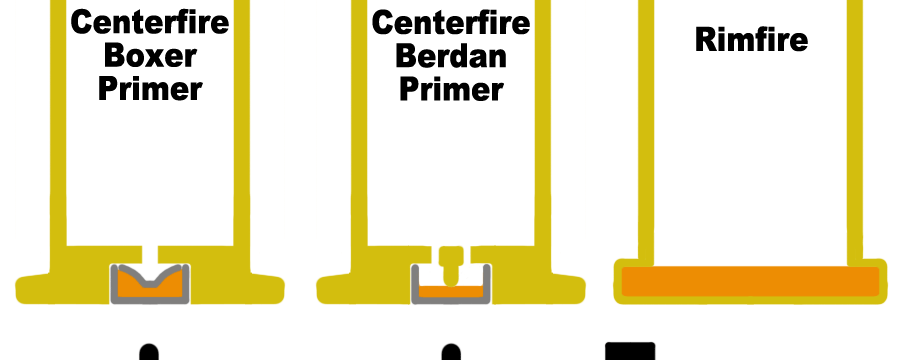
Boxer primers fire through one centralized hole in the bottom of the case and contain the anvil against which the priming compound is crushed. They are significantly more popular than the alternatives for modern handgun and rifle cartridges. Boxer-primed cases are easy to reload.
Berdan primers are designed to fire through two holes in the case’s head, which contains the anvil against which the priming compound is crushed. This convex anvil is in the location of the hole that a Boxer-primed case contains. Berdan-primed brass is very rare in modern arms – it is popular in Europe, mostly with older military surplus rifles and handguns. It is not easy to reload Berdan-primed cases and is generally not worth the trouble. One should at least know the difference between Boxer and Berdan primers because most Berdan priming compounds are corrosive and must be cleaned out after the gun is fired.
How to identify the two: Look into an empty cartridge case. If you see one hole at the bottom, it is Boxer-primed. Two smaller holes on either side of the center tells you it is Berdan primed. Unless you are loading for a very rare, hard-to-find Berdan-primed cartridge, you usually will just throw the empties away. Berdan-primed cases are not worth the trouble, trust me.
There are two basic sizes of primers, large and small, and two different power levels, standard and magnum. This is true for both pistol and rifle primers.
Powder
The propellant that is ignited by the primer and burns which in turn pushes the bullet down the barrel and out the muzzle. There are many different types of powders, each of which performs one or more specific tasks well. Slower-burning powders are used in magnum cartridges, typically. These powders usually require a larger amount loaded into the case and burn at a slower rate. This is what is needed to move a large bullet down a long magnum revolver’s barrel at maximum velocity. On the other end of the spectrum, there are fast-burning powders that excel at lighter target loads or rounds to be used in semiautos with their shorter barrels. The selection of powder is a topic in itself, involving numerous intricacies and considerations. It requires careful evaluation of details and variables to determine the most suitable powder for a particular application.
Bullet
The projectile which is shot out the gun’s muzzle when the primer ignites the powder. Notice that the bullet is ONLY the projectile…do not call the entire cartridge a “bullet.†It is called a cartridge for good reason.
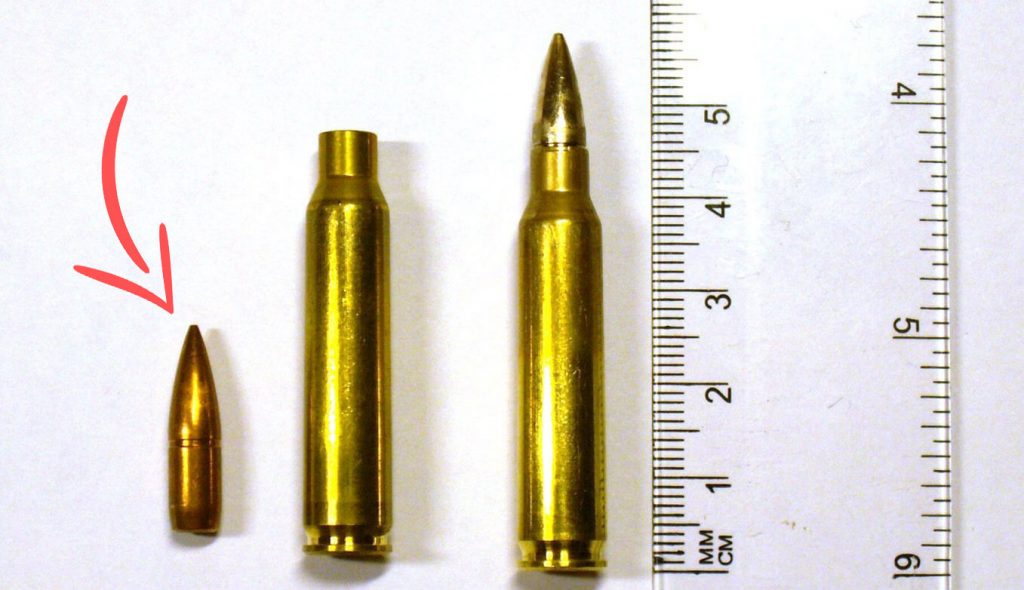
There are thousands of bullets available, but for our handgun-related purposes here we discuss cast lead bullets or jacketed bullets. Each has its uses. Suffice it to say that, in general, cast bullets are used in target loads at lower velocities or in magnum-level hunting loads in both revolvers and semiautos. Jacketed bullets (jacketed hollow point, JHP or jacketed soft point, JSP) tend to be used in self defense or hunting loads as their reason for being is to expand to a greater diameter after striking the target in order to increase incapacitation of that target. As with cast bullets, jacketed bullets may be fired in either revolvers or semiautos. (One caveat: some manufacturers of semiauto pistols warn against shooting non-jacketed bullets in their guns due to chamber dimensions and rifling type).
The Cartridges
OK…we know now what the different numbers and terms mean…how about looking at each cartridge in some detail?

Some of the stories behind their development are quite fascinating. It’s important to note that research and development for new cartridges are ongoing. Who knows, in five years, a guide like this one might feature several new rounds!
Please keep in mind that it is very difficult to list just one representative bullet weight, velocity, energy, etc. for each cartridge. There are many variables that can affect these numbers: barrel length, bullet weight, type of load (defensive or target), type of gun, powder charge…I have listed what are, to the best of my knowledge and experience, truly cartridges representative for each caliber. I looked through several books and online ballistics sources to arrive at these selections. I therefore tried to determine a “representative†load for each caliber. Just remember, as those who write in the gun forums like to say, your mileage may vary.
Special Note to Reloaders…I have included,as part of the data description of each cartridge what I call a “Reloadability Factor†– this will be scale from 1 – 5 with 1 being very difficult or expensive to reload and 5 being the easiest. If you need more information about reloading, here is an article that may help.
Let’s start by taking a look at rimfire cartridges.
.22 Rimfire Cartridges
.22 rimfires come in three different styles (not counting magnum or specialized loads):
 Short: A .421-inch-long case firing a 29- or 30-grain bullet. This was America’s first metallic-cased round.
Short: A .421-inch-long case firing a 29- or 30-grain bullet. This was America’s first metallic-cased round. Long: A .613-inch-long case firing the same bullet as the Short.
Long: A .613-inch-long case firing the same bullet as the Short. Long Rifle: The same case as the .22 Long firing a nominal 40-grain bullet.
Long Rifle: The same case as the .22 Long firing a nominal 40-grain bullet.
The Long is not seen today for the most part although Shorts are available. Some like to hunt small game with Shorts due to their lack of noise. They will not feed in most semiauto pistols or rifles. We will look in some detail at the most popular rimfire going, the .22 Long Rifle.
.22 Long Rifle
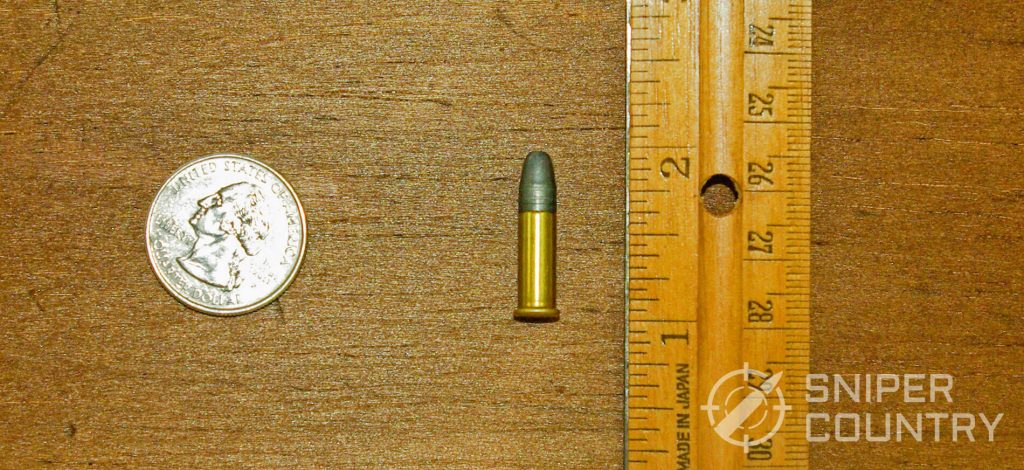
| .22 Long Rifle Stats | |
|---|---|
| Type Of Handgun | Semiautomatic |
| Representative Barrel Length | 5.5 inches |
| Typical Bullet Weight (grains) | 40 |
| Typical Muzzle Velocity (fps) | 1100 |
| Typical Muzzle Energy (ft-lbs.) | 105 |
| Recoil Energy (ft-lbs.) | 0.67 |
| Reloadability Factor | 0 |
The .22 Long Rifle (.22 LR) stands out as the most widely sold cartridge globally today, with annual production figures ranging between two and two and a half billion rounds. Its immense production underscores its popularity as a favorite among shooters. Many of us have grown up using this cartridge, and most shooters still own at least one .22 LR handgun. It is extensively used for recreational shooting, hunting, informal target practice (“plinking”), competitions, training, and for introducing new shooters to the sport. Its minimal recoil and low noise level make it exceptionally suitable for these applications and more.
The .22 LR is the only round discussed here that uses a heeled bullet. All other bullets in cartridges on our list fit inside the cartridge case. With the .22 LR, only a small portion of the bullet base, the “heelâ€, fits inside the case. The remainder of the bullet is bore diameter and rests outside the case. A special lubrication is used that does not rub off.
Bullets are made with a solid nose, or a type of hollowpoint. There are some special hunting and defense loads for the .22 LR that yield hyper velocities. Bullet weights as low as 30-32 grains can be pushed as high as 1500-1800 fps or higher in some cases. Nominal figures for the .22 LR are given below. The cartridge sells so well because, in addition to its other traits listed above, it is one of the most versatile rounds for handguns out there. It’s no wonder that rimfire round production is so high. Unfortunately, rimfire cartridges cannot be easily reloaded. Well…they can but it takes some very specialized equipment. Most reloaders choose to not jump through those hoops so they buy their .22s at the store. Hence the “0†for the Reloadability Factor. For more on the history of the .22 Long Rifle and some handgun suggestions, read this article.
This Load: The load described here is the typical representative bullet weight loading of 40 grains. There are more .22LR and .22 Magnum loads out there than you could shoot in a month of Sundays, so I mention the standard 40-grain loading at around 1100 fps. With .22LR, you can get faster (hyper-velocity) or slower (subsonic) loads for specific purposes but if you want a plain-jane plinking load, here you go.
.380 ACP
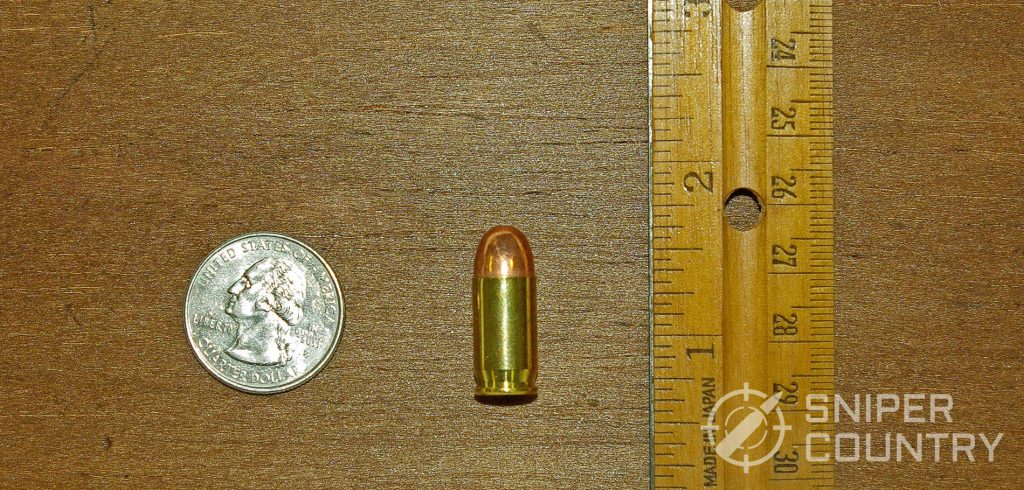
| .380 ACP Stats | |
|---|---|
| Type Of Handgun | Semiautomatic |
| Representative Barrel Length | 3 inches |
| Typical Bullet Weight (grains) | 95 JHP |
| Typical Muzzle Velocity (fps) | 950 |
| Typical Muzzle Energy (ft-lbs.) | 185 |
| Recoil Energy (ft-lbs.) | 3.5 |
| Reloadability Factor | 3 |
A shot from a .380 helped start World War I. Serbian nationalist Gavrilo Princip used a .380 to assassinate Archduke Franz Ferdinand of the Austro-Hungarian Empire. One thing led to another after the shooting which ultimately started WWI.
Introduced in 1908 by Colt for its Colt Model 1908 pocket hammerless semi-automatic pistol, the .380 ACP (Automatic Colt Pistol) has remained a popular choice for self-defense ever since. Another popular name for it is the 9mm Kurz (“shortâ€, if you’re not up on your German). It uses the same bullet diameter of the 9mm – .355 – but .380 bullets are lighter (95-105 grains). A locked-breech pistol is not normally required for the .380 due to its lower pressures but some of the better examples of .380 pistols utilize that build feature.
At one time, the .380 was considered a fairly powerful cartridge. It replaced the .32 Auto by and large and today is the premier pocket pistol caliber. Modern self-defense loadings turns the .380 into a viable self defense round. Some experts suggest its stopping power is comparable to that of a 158-grain .38 Special lead round-nose cartridge. While not as powerful as a 9mm, many people prefer it for concealed carry due to its compact size, quick deployment, and greater impact compared to smaller calibers like .22 or .32. This has contributed to its increasing popularity in recent years.
Personal Experience
I’m one of those unconventional reloaders who actually reloads the .380 cartridge. Given the high cost of factory ammunition, it’s practical to “roll your own” when it comes to this caliber. I typically use either a 95-grain cast round nose or a 105-grain cast truncated cone flat point bullet. While I plan to eventually acquire a bullet mold and start powder coating my own bullets, these commercially-cast options perform well for now.
Here’s a piece of unsolicited advice: shooting the .380 accurately can be challenging due to the small grip frame and often rudimentary sights found on most pocket pistols. There are exceptions, of course – see my article on the best .380 handguns if you are interested. It is also not a gun I would hand a brand-new shooter unless that gun was the size of a 9mm or so. Tiny guns require more practice, not less.
This Load: The load described here uses the typical, representative bullet weight for the .380 which is 95 grains. There are lighter loadings, some as light as 60 grains and also heavier ones but the advantage of using this type of self defense loading with a 95-grain bullet is that you can buy bulk 95-grain FMJ ammo to practice with. That is a good plan – practicing with the same bullet weight you carry.
.38 Special
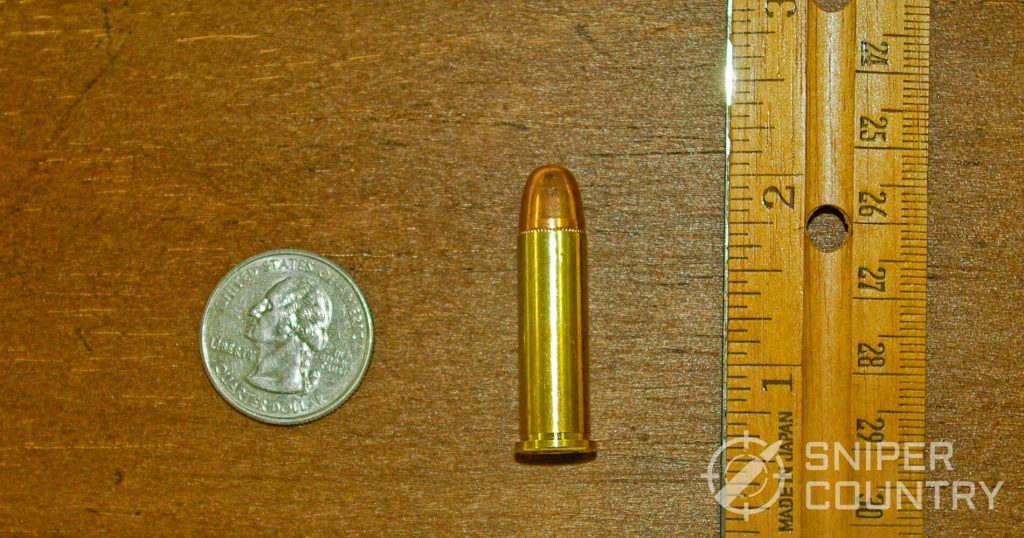
| .38 Special Stats | |
|---|---|
| Type Of Handgun | Revolver |
| Representative Barrel Length | 4 inches |
| Typical Bullet Weight (grains) | 130 FMJ |
| Typical Muzzle Velocity (fps) | 890 |
| Typical Muzzle Energy (ft-lbs.) | 230 |
| Recoil Energy (ft-lbs.) | 3.14 |
| Reloadability Factor | 5 |
The .38 Special was designed in 1898 to be a more powerful round than the .38 Long Colt. The Long Colt round was ineffective during the Philippine Insurrection, so something better was needed. This led to the .38 Special. Police forces started adopting it until it became the de facto “official†police cartridge. In the late 1920s, the Western Cartridge Company introduced the .38 Super Police, a 200-grain lead round-nosed .38 Special cartridge. Subsequently, various other loads emerged, and many police departments adopted the .38 Special. It reigned supreme for a few years until the .357 magnum, and later the 9mm, took its spot as the top dog law enforcement cartridge.
It is one of the most versatile handgun cartridges out there. Reloaders love it; you can put together loads that are great for punching holes in targets with full wadcutter bullets or drop a different powder in and load jacketed hollow points for self defense. The standard bullet weight of 158 grains has been eclipsed a little by lighter bullets that can be driven faster. In this day and age of polymer “plastic wonder†pistols (as some shooters call them), it’s important to remember that plenty of snub nosed revolvers are carried daily, and most of them are chambered in .38 Special. It’s been around since the 19th century but shows no signs of fading away. In fact, with modern bullet technology, it’s more popular than ever.
This Load: The load described here is not the typical, nominal .38 Special bullet weight of 158 grains but instead one that uses a 130-grain FMJ bullet. To be sure, there are as many .38 Special loads out there as there are different guns to shoot them in but unless you are using a six-inch barrel you will not get the velocity you are expecting. The 125- to 130-grain class of bullet weight is a good place to start.
.357 Magnum
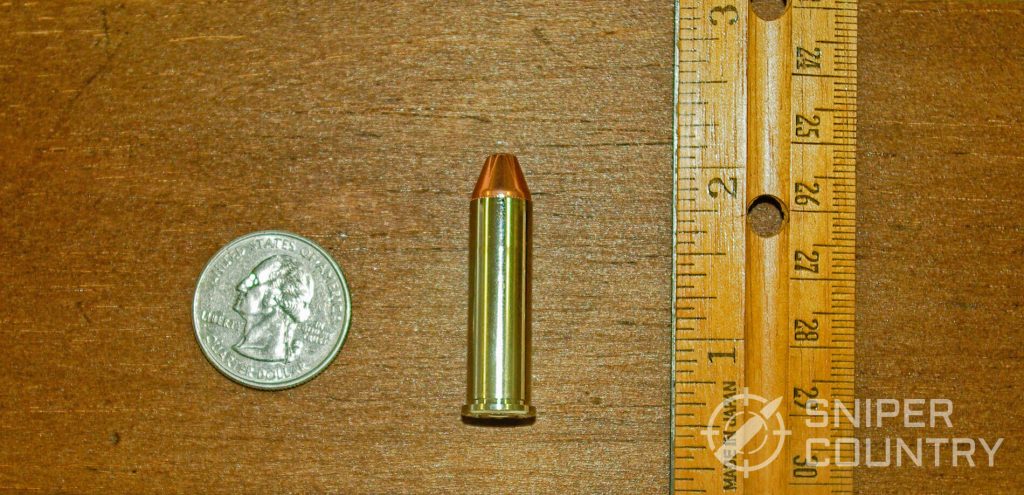
| .357 Magnum Stats | |
|---|---|
| Type Of Handgun | Revolver |
| Representative Barrel Length | 6 inches |
| Typical Bullet Weight (grains) | 125 JHP |
| Typical Muzzle Velocity (fps) | 1450 |
| Typical Muzzle Energy (ft-lbs.) | 620 |
| Recoil Energy (ft-lbs.) | 10.4 |
| Reloadability Factor | 5 |
The .357 Magnum was developed in 1934 and introduced the following year as touted to be “the most powerful handgun cartridge” available. Some shooters, wanting to impress their friends, said that you needed to wear gloves when you shot it due to its vicious recoil. This is a matter of conjecture, not to mention personal taste. I have owned, or do own, .357 revolvers and will testify that it does kick like a mule with the right loads but is by no means uncontrollable. With the advent of more powerful rounds like the .44 Magnum, .460 S&W Magnum, .480 Ruger, .45 Casull etc., the .357 seems downright tame.
What really got the .357 going in terms of sales was when Phil Sharpe and others traveled around the world, hunting all types of big game with an 8 ⅜ inch Registered Magnum .357. This contributed significantly to its enduring reputation. Revered by revolver enthusiasts as the ultimate cartridge, reloaders find it particularly rewarding. Whether for deer or larger game where permitted, the .357 Magnum remains a preferred choice among handgunners.
This Load: The load described here is, perhaps, the most effective .357 round out there for all-around use. It is important to note that many police agencies who issued the .357 used some form of 125-grain loading. There are both heavier and lighter bullets loaded in the .357, but the 125-grain is a great place to start.
9mm
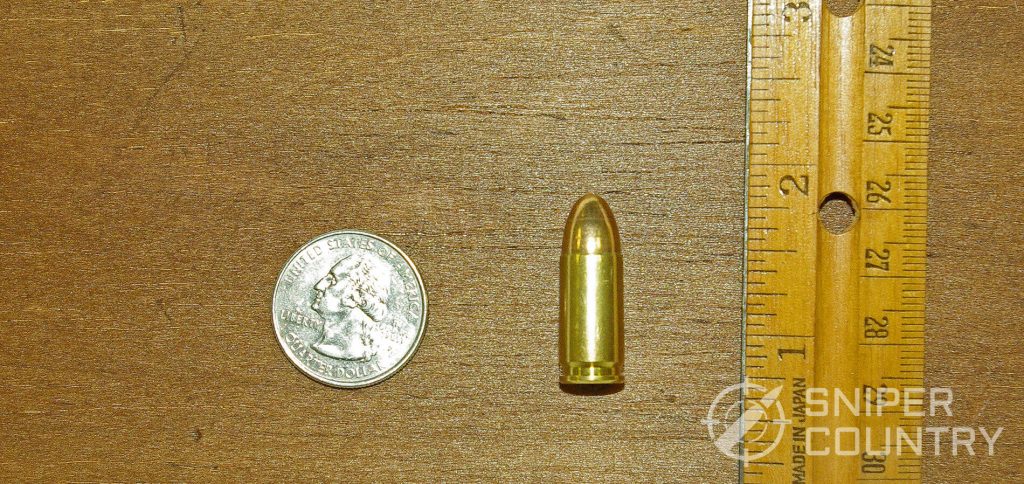
| 9mm Stats | |
|---|---|
| Type Of Handgun | Semiautomatic |
| Representative Barrel Length | 4 inches |
| Typical Bullet Weight (grains) | 115 JHP |
| Typical Muzzle Velocity (fps) | 1145 |
| Typical Muzzle Energy (ft-lbs.) | 335 |
| Recoil Energy (ft-lbs.) | 7.5 |
| Reloadability Factor | 5 |
The 9mm round first appeared in 1902 with the P-08 Luger pistol, designed by Georg Luger. It has been popular in Europe since its introduction (many small arms that were used in both World Wars were chambered in 9mm). And, according to the 2014 edition of cartridges of the World, it is the most popular caliber worldwide. The 9mm gained significant traction in the United States after World War II, when GIs brought back trophy weapons from Germany. Initially, ammunition availability was limited, but as the demand for 9mm surged, ammunition companies ramped up production to meet the growing market.
Law Enforcement Agencies, Military Adopt The 9mm
Over 20 years post-WWII, police agencies started using the 9mm. The Illinois State Police were the first state agency to adopt it, along with the S&W Model 39 semiauto pistol in 1967. Then, in 1985 our military adopted the 9mm and the Beretta M9 as a replacement for the classic .45 ACP 1911, many of which were wearing out. By doing so, they also adopted a round that was a Nato standard. When the F.B.I adopted the round, law enforcement agencies followed suite. Likewise, when police agencies adopted it, civilian concealed-carriers saw that as a stamp of approval and began buying 9mm guns. With the huge array of ammo of all types, the 9mm’s future seems secure. When you factor magazine size into the equation with some magazines holding 19 rounds, it is pretty easy to have the equivalent of a full box of 50 rounds on your person if you carry two spare magazines. That is another reason for the 9mm’s popularity.
With the military’s adoption of the 9mm as an official NATO cartridge, surplus and bulk ammunition are readily available. Buying in bulk, such as a minimum of 1,000 rounds with shipping included, offers attractive deals. This availability underscores the advantage of using a globally popular cartridge. The 9mm’s moderate recoil and reasonable cost make it an optimal choice for many shooters.
This Load: The load described here is the 115-grain JHP, not the 124-grain or the 147-grain. Any of these bullet weights will work; I had to pick something that is readily available. Please do not think that this 115-grain load is the “best†– it’s just representative of what’s out there. For example, the F.B.I. is using Winchester’s PDX-1 147-grain load. The great thing about the 9mm is that there ARE so many different loads to try. Here is a really good one to start with, easy in the recoil department and fast to get back on target. For more on the 9mm, read my articles highlighting the best 9mm ammo and pistols for it.
.40 S&W
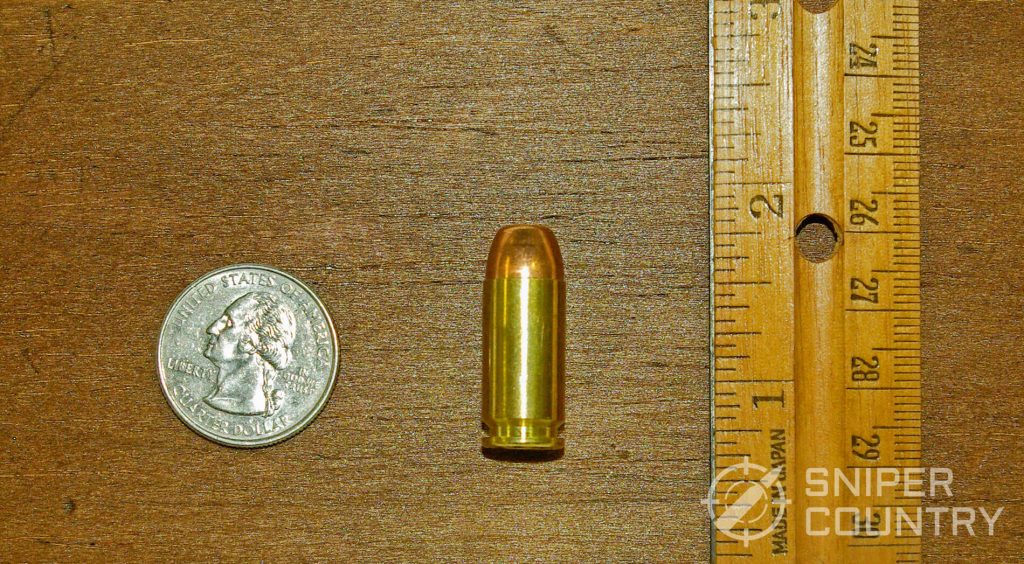
| .40 S&W Stats | |
|---|---|
| Type Of Handgun | Semiautomatic |
| Representative Barrel Length | 4 inches |
| Typical Bullet Weight (grains) | 180 JHP |
| Typical Muzzle Velocity (fps) | 1050 |
| Typical Muzzle Energy (ft-lbs.) | 400 |
| Recoil Energy (ft-lbs.) | 10.2 |
| Reloadability Factor | 5 |
The .40 S&W (Smith and Wesson) has a rather colorful history. Originally, it was designed to mimic the F.B.I.’s reduced-velocity 10mm load. After deciding that the 10mm, in its original form, was too much for agents to handle, the F.B.I. had it brought out in a reduced loading. Smith and Wesson and Winchester worked on an original cartridge, loaded to that velocity level, that was easier on agents and could be shot in 9mm-sized pistols. Shortening the case to .850 and downloading the 10mm to lower pressures yielded what became the .40 S&W.
Even though both the .40 S&W and the 10mm use a .401 in. diameter bullet, there the similarity ends. The two rounds tend to remind me of the difference between the .38/.44 Specials and their magnum counterparts. The .40 S&W is a lower-pressure round designed to be easier shoot, as noted above but it can still be snappy in a lighter pistol. It tends to be loaded to one of two pressure levels (both within its limitations, of course) – a slightly downloaded version and a full-bore cartridge loaded close to the .40’s peak pressure of 35,000 p.s.i. The former makes a good target round, while most self-defense rounds are loaded to the latter’s pressure level. The industry does this, in my opinion, to make the .40 more palatable to a broader range of shooters. Some folks only want so much recoil and blast and are happy with the lower-pressure round while others want or need the full-tilt, big-ball-of-flame-out-the-muzzle hand thumpers. Either way, the .40 S&W is a viable self defense load. It is legal for deer in my state, out of at least a four-inch barrel.
On the Decline?
More than one respected gunwriter has, for the past couple of years, written pieces about the “death†of the .40 S&W. One major manufacturer, who released a new pistol in 9mm and then in .45ACP was asked if they were going to make it in .40, to which he replied “no†U this would make one wonder about the .40’s future. I believe the reason for the decline (if you could call it that) of the .40 is that 9mm bullets have gotten better, and that the old .45 has made yet again another comeback in popularity. I don’t see the round disappearing from dealer’s shelves anytime soon, but when law enforcement agencies (including the F.B.I.) back away from it to go to the 9mm, maybe there is something to it. The F.B.I. adopted the .40 S&W in 1997 and used it until they switched to their specialized Glock 19 9mm in 2016. Although some agencies still use the .40, its heyday seems to be behind it. Despite varying opinions, the .40 S&W remains accessible and effective.
This Load: Â The load described here represents the typical bullet weight for the .40 S&W, with the 150-grain bullet being another popular choice. It’s widely available in most stores that sell ammunition and serves well as a versatile all-around load.
10mm
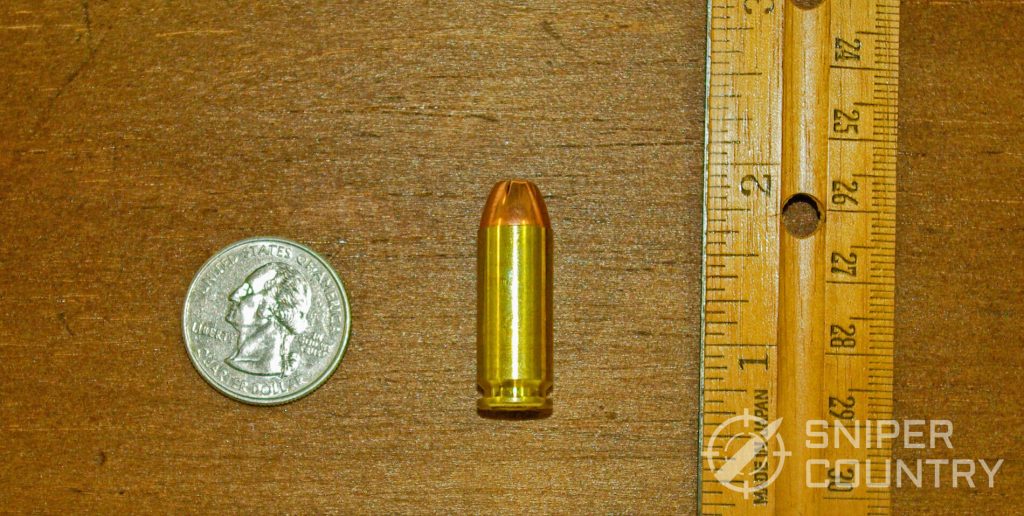
| 10mm Stats | |
|---|---|
| Type Of Handgun | Semiautomatic |
| Representative Barrel Length | 5 inches |
| Typical Bullet Weight (grains) | 180 |
| Typical Muzzle Velocity (fps) | 1240 |
| Typical Muzzle Energy (ft-lbs.) | 615 |
| Recoil Energy (ft-lbs.) | 11.8 |
| Reloadability Factor | 4 |
“Katy, bar the door!†Ka-BOOM! That’s the common perception of the 10mm. The 10mm is one of the more popular cartridges out there in the field now. Where did it come from?
A Quick History of the 10mm
The 10mm cartridge evolved from an earlier round developed by Jeff Cooper, Thomas Dornhaus, and Michael Dixon, known as the .40 Super. Dornhaus and Dixon also created the Bren Ten pistol, based on the CZ-75 design. Despite their innovative work, their company went bankrupt in 1986. However, the Swedish ammunition manufacturer Norma continued producing the 10mm cartridge. The FBI adopted this round in 1989 but found its recoil too powerful for general use. The agency subsequently adopted a downloaded, shorter version, leading to the creation of the .40 S&W.
The 10mm is effective for hunting deer and hogs up to distances of 75 yards or more, in capable hands. Legal for deer in many states, the hotter loadings are preferred for achieving successful hunts. Some handgun hunters liken its velocity and energy to that of the .41 Magnum, though it falls between the .357 and .41 Magnums in terms of energy output. It often surpasses many .357 Magnum loadings in energy, especially with heavier bullets. Carrying a semiautomatic with a five-inch barrel and a magazine holding a dozen rounds provides a sense of security in the woods. Similar to the .40 S&W, the 10mm is available in various loadings, from lighter practice rounds to potent loads suitable for hunting.
Should You Use The 10mm For Self Defense?
In terms of self defense, a pistol chambered in 10mm is normally carried with the lighter loads as these are usually stout enough for carry without being overly powerful. Recovery time after the shot is affected by how much recoil is generated, so the lighter loadings will allow faster follow-up shots in most cases. There are those self defense experts who think the 10mm is too much for concealed carry, at least in its full-bore loadings. They are concerned about over-penetration causing what is euphemistically known as collateral damage (read: innocent bystanders catching a bullet that went completely through the bad guy) and inability to get the front sight back on target after a shot due to the stout recoil. As with anything remotely related to guns and shooting, there are always exceptionsU one size (or opinion) definitely does not fit all.
Having said that, the 10mm cartridge is definitely worth a look if you are wanting a multi-purpose round that you can use at the range, carry, or hunt big game with. Its star is rising, as it is more popular now than pretty much any time since its introduction. You may want to check it out.
This Load: The load described here is the 180-grain loading at “real†10mm velocity. There are subloadings that are easier on the gun and the shooter but if you are wanting the true 10mm experience, give this or similar loads a try.
.44 Special
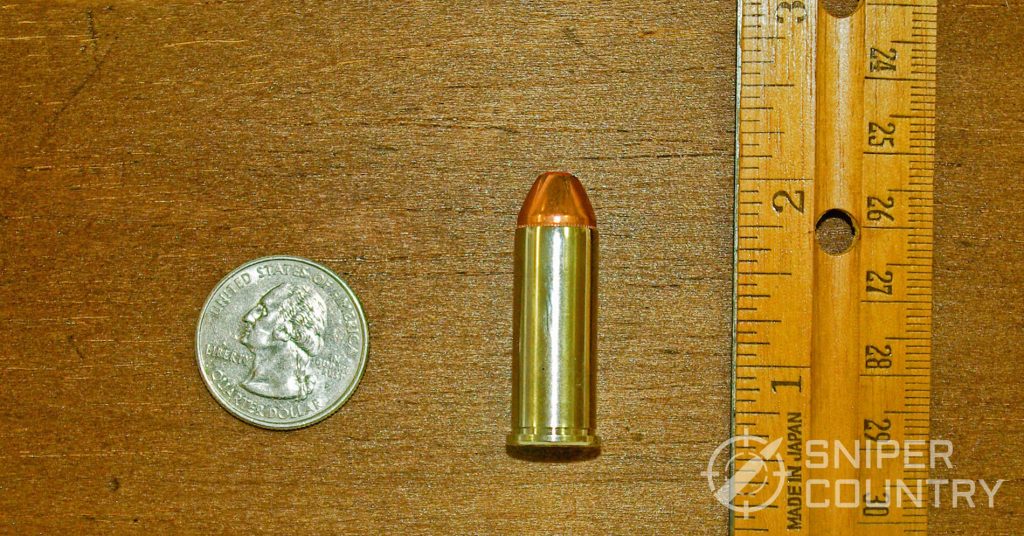
| .44 Special Stats | |
|---|---|
| Type Of Handgun | Revolver |
| Representative Barrel Length | 4 inches |
| Typical Bullet Weight (grains) | 200 |
| Typical Muzzle Velocity (fps) | 1075 |
| Typical Muzzle Energy (ft-lbs.) | 513 |
| Recoil Energy (ft-lbs.) | 14 |
| Reloadability Factor | 5 |
Elmer Keith, the father of the .44 Magnum, was the .44 Special’s biggest cheerleader back in “the day.†He probably blew up more guns in his experiments with heavy loads then I will ever own. To this day, the .44 Special is still a popular cartridge with a large following. It is also a reloader’s dream. So, where did it come from?
Enter The Russian
This caliber was quite popular during that period, although there were several other lesser-known variants in circulation. As the transition from black powder to smokeless powder occurred, the .44 Russian fell short in terms of velocity. To address this, Smith and Wesson extended the case length of the .44 Russian by 0.19 inches and thus created the .44 Special. However, they did not fully capitalize on the ballistic advantages offered by smokeless powder in a longer case, retaining the .44 Russian’s ballistics with a 246-grain lead bullet at 755 fps.
This is where Elmer Keith and others come in. He, along with the rest of the “.44 Associatesâ€, began experimenting with heavier loadings in the .44 Special. They wanted to take advantage of the round’s full potential so they developed some pretty hefty .44 loads. Keith was particularly enthusiastic about introducing a new variant known as the “.44 Special Magnum.” However, Smith and Wesson had concerns about the potential use of these powerful loads in older black powder-framed revolvers. To address this, they extended the case length by 0.128 inches, ensuring that the round would not chamber in a standard .44 Special revolver. This modified version was named the .44 Remington Magnum, with Remington receiving credit for its involvement in the ammunition’s development. The .44 Magnum will be discussed further below.
A Very Useful cartridge
The .44 Special is a very useful cartridge in its own right. Since day one, it has been renowned as an accurate target round. Adjust the powder type and amount and add a hard-cast 250 grain semi-wadcutter bullet and you have an excellent hunting round. Elmer and his buddies took all types of game, both big and small, with the .44 Special in its heftier incarnation. As a reloader, I have shot many .44 Special reloads in guns ranging from my Charter Arms Bulldog snubby up to my 8 ⅜†Smith and Wesson 629 .44 Magnum, always with pretty much the same result: holes in the target close together. I even used one .44 Special load from Georgia Arms, a 240-grain JHP, to kill a deer at a measured 104 yards with my 629. That’s pushing it, I know, for an iron-sighted revolver (I didn’t have a rangefinder) but it put the doe down for the count. Again, this was not a magnum load – the headstamp on the factory-fresh case said “44 Spl.†This was the only deer killed by me with that gun where I used a factory load, not a cast-bullet reload from my reloading bench. The point is – don’t sell the .44 Special short. There are many times I’ve hunted with a .44 with ammo that didn’t say “Magnum†anywhere on the cartridge case. With modern defensive ammo, the old .44 is right at home in a concealed carry revolver or on a nightstand. Drop some hunting ammo in the cylinder and you have a very handy close-range deer gun. Try it – you will most likely be surprised at the results!
This Load: The load described here is a 200-grain JHP bullet load, not the standard 246-grain. I chose this load as opposed to the ages-old .44 Special loading of a 246-grain lead bullet at (optimistically) 750 fps. Notice the nickel-plated case and the modern Hornady expanding bullet. The load here will be more fun to shoot and can double as a hunting or self defense round, within reason.
.44 Magnum
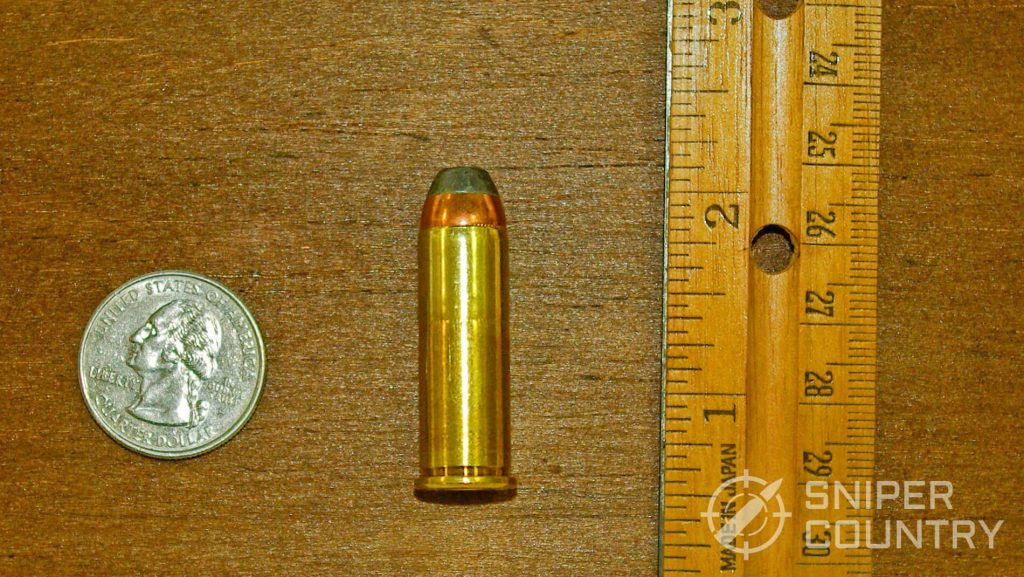
| .44 Magnum Stats | |
|---|---|
| Type Of Handgun | Revolver |
| Representative Barrel Length | 6 inches |
| Typical Bullet Weight (grains) | 240 |
| Typical Muzzle Velocity (fps) | 1230 |
| Typical Muzzle Energy (ft-lbs.) | 806 |
| Recoil Energy (ft-lbs.) | 16.9 |
| Reloadability Factor | 4 |
Elmer Keith, mentioned earlier for his contributions to this cartridge, played a pivotal role in developing what are known as the “big three” magnums: the .357, .41, and .44. He is widely recognized, and in some circles revered, for his pivotal work that led to the creation of the .44 Magnum. As previously discussed, his primary goal was to develop a robust .44 caliber cartridge suitable for hunting purposes. Alongside Remington and Smith & Wesson, Elmer was instrumental in the development of what we now refer to as the .44 Magnum (technically designated as the .44 Remington Magnum). The first revolver chambered to fire the .44 Magnum cartridge was the S&W Model 29 with the prototype seeing the light of day in December, 1955. It was publicly introduced in January of 1956 at a MSRP of $140. Bill Ruger got into the act later that year, bringing out the .44 Blackhawk (soon to be the Super Blackhawk) that summer. .44 Magnum guns are somewhat specialized, popular with handgun hunters. Another bonus for hunters was (and is) the availability of handy carbines chambered in .44 Magnum, either lever actions or semiautos. (Ruger had made a semiauto carbine for the .44 that is out of production but which you still might be able to find on the used market). Having two guns that shoot the same cartridge is a plus, as many in the 19th century American West found out with the .44-40 cartridge.
Enter Dirty Harry
The .44 Magnum gained widespread popularity among revolver shooters primarily due to its prominent role in the movie “Dirty Harry” in 1971, where a six-inch Model 29 was prominently featured. Following the film’s release, Smith & Wesson faced unprecedented demand and struggled to keep up with production. Finding one for purchase was a challenge, and those available often commanded prices well above the manufacturer’s suggested retail price (MSRP). It took several months for production to match the soaring demand, eventually making the firearms more accessible as the initial frenzy settled down.
“44+6â€
Shooting the heavy .44 Magnum loads of that time caused different reactions by those who had bought the Model 29 or the Blackhawk. For some of them, the cartridge was exactly what they wanted for hunting, and so they really liked it for that purpose. Others…well, not so much. After supply caught up with demand and many shooters bought the big .44, it was not unusual to see the gun in the used gun counter at the gun shop complete with a box of .44 Magnum ammo with exactly six empty, primer-dented cartridge cases and 44 loaded rounds in the box. One cylinder full convinced the shooter that maybe the gun was a bit much for them. This was before companies started to roll out mid-range loads that were basically like a .44 Special on steroids but nothing like the snorters that belched a two-foot-stream of fire from the muzzle when fired.
Personal Experiences With The .44 Magnum
I remember those days well. I have owned three .44 Magnums – a 7 ½ inch Super Blackhawk, a 6 inch Model 29 (just like Dirty Harry’s!) and my current gun, an 8 â…œ inch Model 629.
I had started reloading by the time I owned the Super Blackhawk, around 1979 or so. I loaded Elmer Keith’s own load, which involved 2400 powder and a 250-grain hardcast semi-wadcutter. I won’t mention how much 2400 was involved. Suffice it to say that, as I practiced for a silhouette shoot, I raised a bone in the wrist of my shooting hand from the stout recoil that the Super Blackhawk generated. So, I backed off a touch and was happier with the results. I traded that gun for the Model 29 (still in demand after the Dirty Harry movies). They were both fine revolvers. I was given my 629 by a dear family friend who had stomach cancer and wanted me to have it because he knew I’d use it, keep it, and would remember him by it. I do not know how many deer that 37-year-old, long-barreled, satin stainless steel gun has taken…many, to be sure. Most have fallen to my mostly mid-range cast bullet handloads with the one exception noted above in the .44 Special section. I will be carrying it on my hip this deer season when I sit in my close blind, with my .243 reserved for the bean-field-distances when I hunt across the road.
If you are looking for an all-around revolver cartridge, give the .44 Magnum a look. Essentially, you’re getting two guns in one—similar to how the .357 Magnum can also shoot the .38 Special. It’s hard to beat that level of versatility.
This Load: The load described here is the standard-bullet-weight 240 grain JHP load that is available at most any store that sells ammo. There are many variations on this load as with any cartridge but this one will get most jobs done that you need a .44 Magnum to do.
.45 ACP
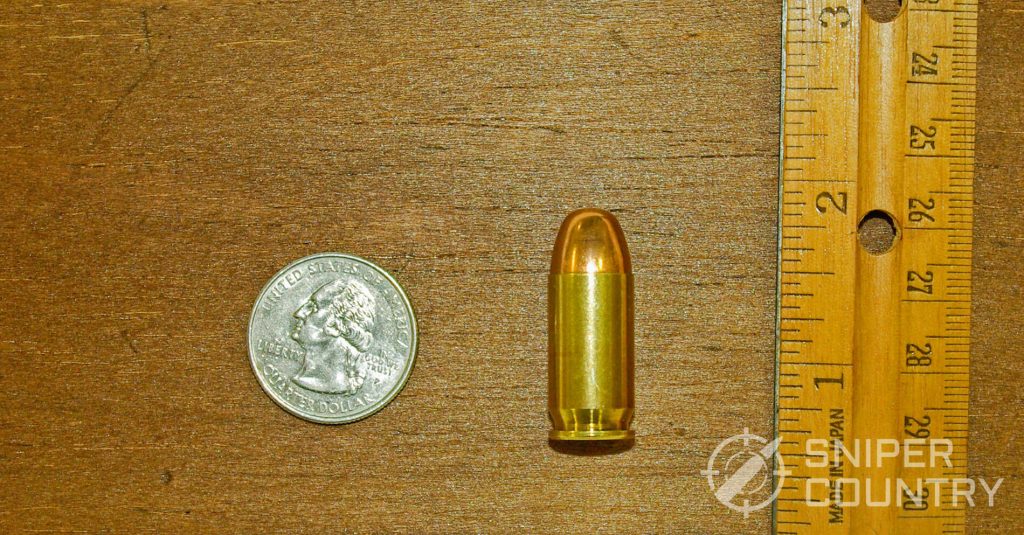
| .45 ACP Stats | |
|---|---|
| Type Of Handgun | Semiautomatic |
| Representative Barrel Length | 5 inches |
| Typical Bullet Weight (grains) | 230 |
| Typical Muzzle Velocity (fps) | 860 |
| Typical Muzzle Energy (ft-lbs.) | 378 |
| Recoil Energy (ft-lbs.) | 6.6 |
| Reloadability Factor | 5 |
“Old Slabsides.†“Colt .45â€. “The Warhorse.†I am describing the legendary Model 1911 pistol, of course, that made its reputation by firing the .45 ACP cartridge. The cartridge today is chambered in many different pistols, not just the 1911. With the availability of guns that will hold fifteen .45 ACP rounds in their magazine (I can think of two at this writing), John Browning’s brainchild is alive and well.
John Browning and the .45 ACP
The cartridge’s history is interesting. In 1904, Thompson and LeGarde of the Army’s Ordnance and Medical Corps respectively were tasked with running cadaver tests to determine which caliber penetrated the furthest, with an eye to introducing a new military round after the failure of the then-current .38 caliber service revolver to incapacitate assailants in the Philippine Insurrection a few years before. They concluded that the new round should be “no less than .45 caliber,” fired from a semiautomatic pistol. This led to the development of the .45 Automatic Colt Pistol (ACP), famously used in the John Browning-designed “Model of 1911” semiautomatic pistol. (For more history and details, check out my article on the best .45 ACP pistols.)
Still Kicking
The .45 ACP is probably more popular now than it has been for over a half-century. What with the profusion of double-stack polymer pistols (not to mention the many 1911s out there) there is no dearth of platforms from which to launch it.
The .45 ACP is very easy to reload, whether you are putting target loads together that barely cycle the action to self defense loads that penetrate a good ways into ballistic gel. The round is especially popular among cast bullet shooters.
Another way to fire the rimless .45 ACP round is in the cylinder of a Ruger Blackhawk. I own a .45 Colt model that includes an additional .45 ACP cylinder. The cylinder’s rim is specifically cut for the shorter ACP case, and it functions flawlessly, with the extractor rod effortlessly ejecting spent casings. Here is another example of a cartridge that is able to be fired in more than one type of gun, adding to its value.
.45 ACP For Silhouettes?
Above, I recounted my experience at a silhouette shoot with my .44 Magnum, firing 250-grain cast semi-wadcutter bullets at approximately 1300 fps. A friend of mine at the shoot used a stock 1911 with factory 230-grain ball ammo for the first two levels (50 and 100 yards). When I hit a target, the sound was a distinct “bang-clang-drop.” When Lynn connected with his semiauto firing the old punkin ball, it sounded more like “bangUUU…clangUUUUU..drop†as the slow-moving bullet hit the steel target eventually. It then took a second or so for the target to decide if it would fall over. The disparity of energy released between the two rounds was enormous, but the point is that even the lowly .45 ACP still had enough energy and momentum at those two ranges to take a fairly heavy steel target down. If you are one of those shooters who won’t carry a concealed weapon unless its caliber starts with “4â€, then the .45 ACP is a natural for you. The rest of us might take a long look at it, as well. You can’t argue with 107 years of success.
This Load: The load described here is the standard 230-grain “ball†load. This is available anywhere and is a great general-purpose load. Self defense loads are available, as are many others but this is “the†standard .45 ACP load. Many purchasers of new .45 ACP guns use it to “break in†their weapons – it works very well at accomplishing that purpose.
.45 Colt (Standard Load)
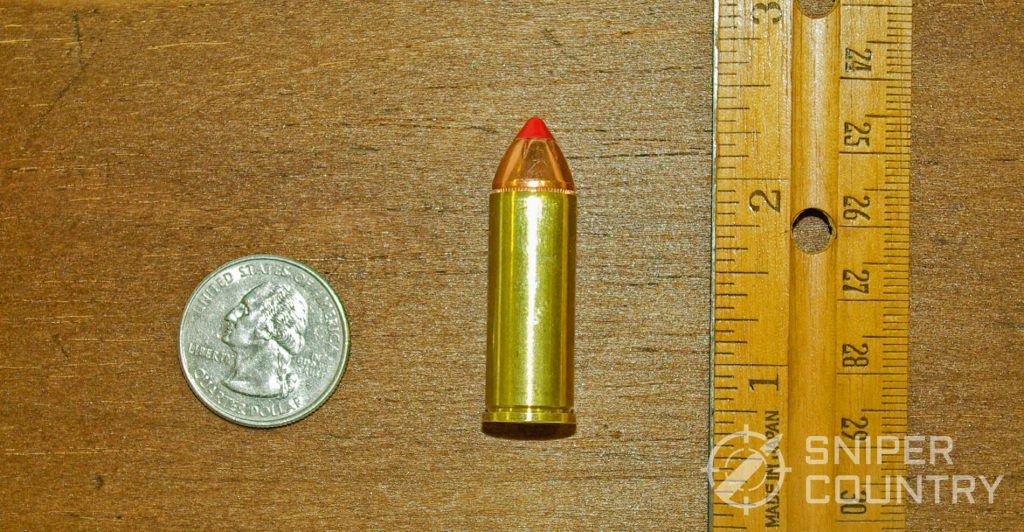
| .45 Colt (Standard Load) Stats | |
|---|---|
| Type Of Handgun | Revolver |
| Representative Barrel Length | 5.5 inches |
| Typical Bullet Weight (grains) | 225 |
| Typical Muzzle Velocity (fps) | 960 |
| Typical Muzzle Energy (ft-lbs.) | 460 |
| Recoil Energy (ft-lbs.) | 10.74 |
| Reloadability Factor | 5 |
From the Army’s Single Action Army revolver of 1873 to the modern single- and double-action revolvers chambered for it, the .45 Colt is one potent cartridge. Its 255-grain bullet in its initial blackpowder loading was quite a manstopper, not to mention being able to drop the horse the adversary was riding. Developed to give the military a more powerful, effective cartridge than what they were using at the time, the .45 Colt has survived and thrived to this day.
History
The .45 Colt boasts a rich and enduring legacy. Originating in 1873, it debuted with a blackpowder load propelling a 255-grain round-nose flat-point bullet at 900 fps. Colt designed its 7 ½ inch barreled Single Action Army (SAA) revolver specifically for this new cartridge, establishing it as the magnum of its era. This revolver retained its prominent status well into the 20th century, even as more powerful cartridges emerged. Continuously produced since its inception, the .45 Colt enjoys renewed popularity today, supported by an expanding array of revolvers chambered for it, ensuring a secure future for this 145-year-old cartridge.
Reloading, Velocities and Personal Experience
One factor that historically limited the .45 Colt’s potential was its conservative loading to avoid risks in older, black powder-era revolvers. Manufacturers feared higher pressures could catastrophically damage these firearms. It wasn’t until fairly recently (in relative terms) that companies began bringing out .45 Colt loads that used modern jacketed bullets at speeds above the old loads because manufacturers started introducing newer, stronger revolvers. Handloaders have dealt with this issue for years. My Lee Cast Bullet Reloading Manual shows .45 Colt loads in two sections: standard-pressure for older revolvers such as the Colt SAA and clones. Ruger-only (or other single action made to withstand the higher pressures) loads are in their own section. The Ruger loads, in some cases, nip at the heels of the .44 Magnum or in some cases surpass it in terms of velocity. The slightly larger .45 Colt case will allow higher velocities with a slightly slower pressure curve than will the smaller .44 Magnum case that peaks faster due to its size and volume.
Three hunting seasons ago, I shot a doe with my .45 Colt 5.5-inch Ruger Blackhawk revolver at a distance of around 75 yards. I was using a Ruger-only load with my hard-cast 255-grain bullet that pretty much duplicates the original bullet introduced in 1873 but cast much harder. The deer went down quickly. I also owned a Rossi lever-action carbine, a copy of the Winchester 1892 model, in .45 Colt. I had killed deer with that, as has my friend to whom I had given it. (Side note: the .45 Colt was not chambered in carbines or rifles in the 19th century. That honor fell to, among others, the .44-40. It is only fairly recently that lever actions are made in .45 Colt). There’s just something about a big, flat-nosed heavy bullet moving at 1000 fps that ends the argument about handgun cartridge effectiveness on deer. One factor that historically limited the .45 Colt’s potential was its conservative loading to avoid risks in older, black powder-era revolvers. Manufacturers feared higher pressures could catastrophically damage these firearms.
This Load: The load described here a modern, ballistic-tipped-bullet version of the .45 Colt that would suffice for self defense or hunting. The old, standard 255-grain lead bullet at around 900 fps was a decent fight-stopper but tended to lead barrels. This fairly new version, a Hornady LEVERevolution, was designed to use in lever action carbines as well as handguns. Either way, you can’t go wrong.
Some Conclusions
Now that we’ve covered the major handgun cartridges, you might be contemplating which one to choose as you browse handguns for purchase. When it comes to rimfires, it’s generally assumed that if you own one or more .22s, you’re already familiar with the various types of rimfire ammunition available.
Here are a few thoughts…
- If you are not a reloader and like revolvers, the .357 Magnum makes a great choice as you can shoot cheaper .38 Specials through it. 357 Magnum is also one of those most versatile cartridges. It is available in light .38 Special loadings to very powerful .357 Magnum loadings. The .44 Magnum and .44 Special also follows the same plan except that ammo is a little more expensive.
- Likewise, if you are not a reloader and like semiautos, the 9mm is by far the most popular round out there and the most available/affordable.
- If you are going to be reloading or already do, any of the rounds mentioned would work. Some are easier than others, as is pointed out above.
- Hunting medium to big game with a handgun requires skill, practice and a gun designed for the jobU .357/.44 Magnum, 10mm, hot-loaded .45 Colt, etc. (Note to Hunters: Using .38 Special-pressure-level ammo for deer hunting is likely illegal and will likely result in a wounded animal. Stick with appropriate ammunition designed for hunting.)
- Do not be afraid to try something new. Don’t hesitate to try something new. If you’ve been eyeing a 10mm for a while and can afford one, go ahead and make the purchase! You can start with lighter loads until you’re ready for the heavier-duty stuff. It’s a great time to add a new gun to your collection.
Most importantly, enjoy yourself as you explore these different cartridges. Shooting should always be a fun and rewarding experience. Remember to prioritize your eye and ear protection, and above all, practice safe handling of firearms.
If you have any questions or thoughts, please leave comments below. I’ll do my best to respond promptly.

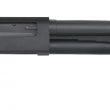
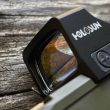
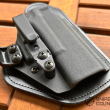
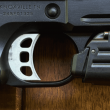
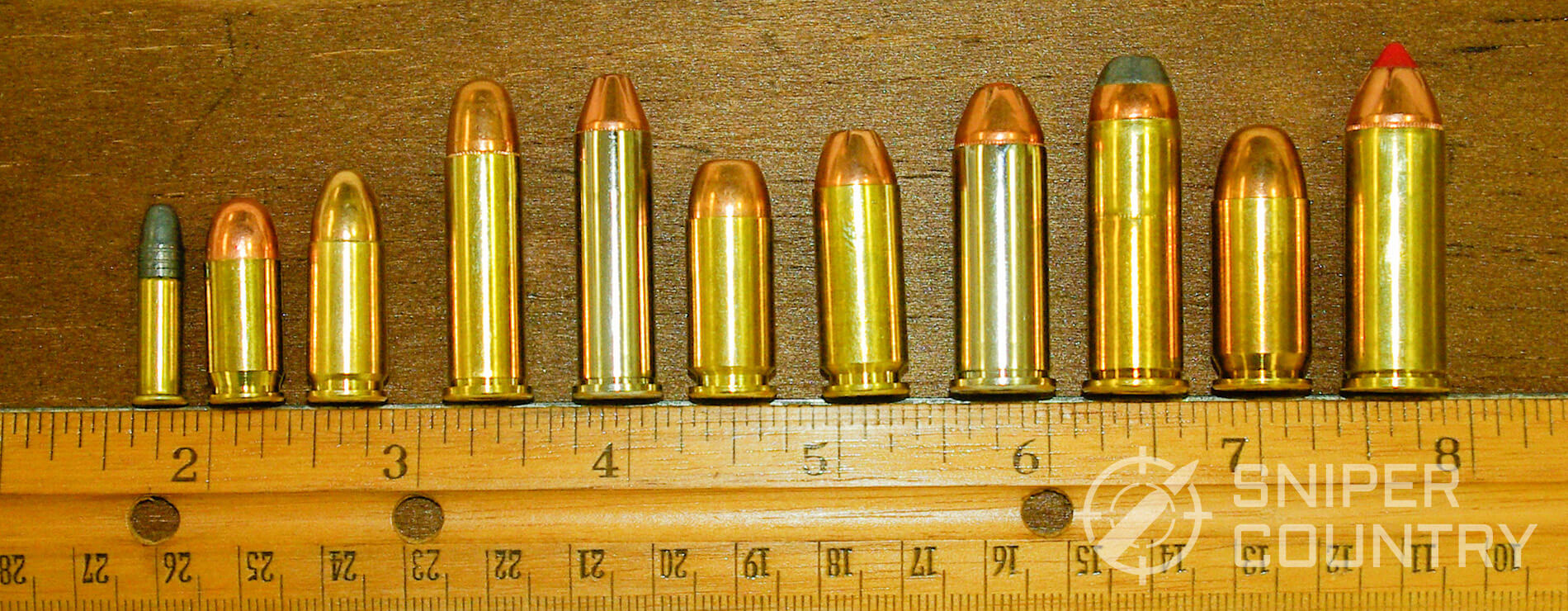
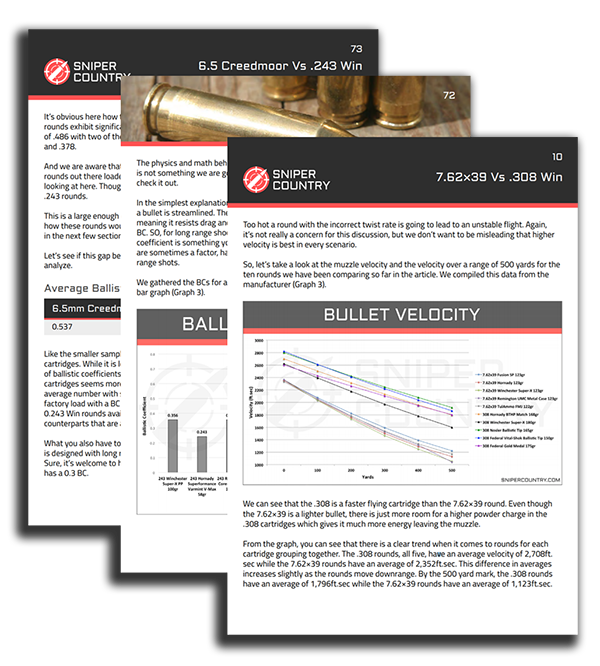

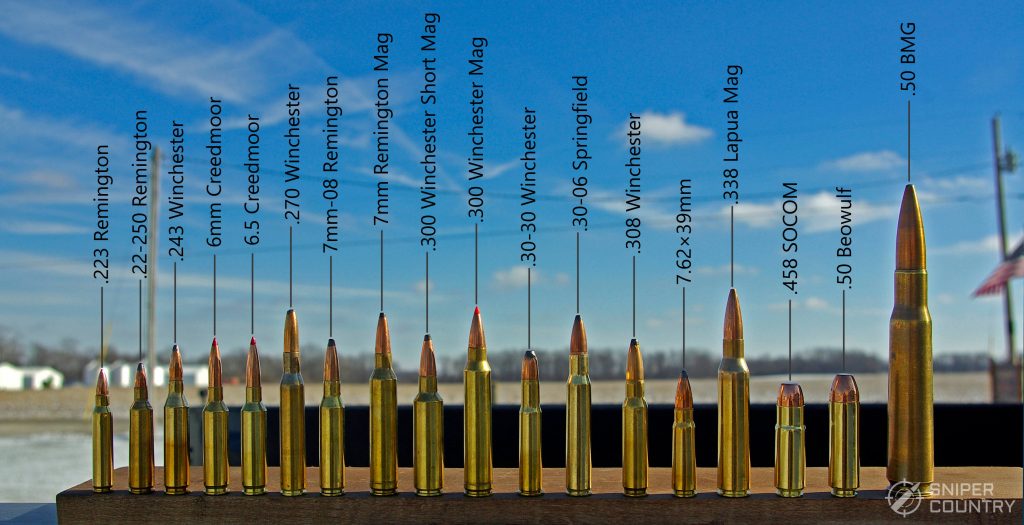
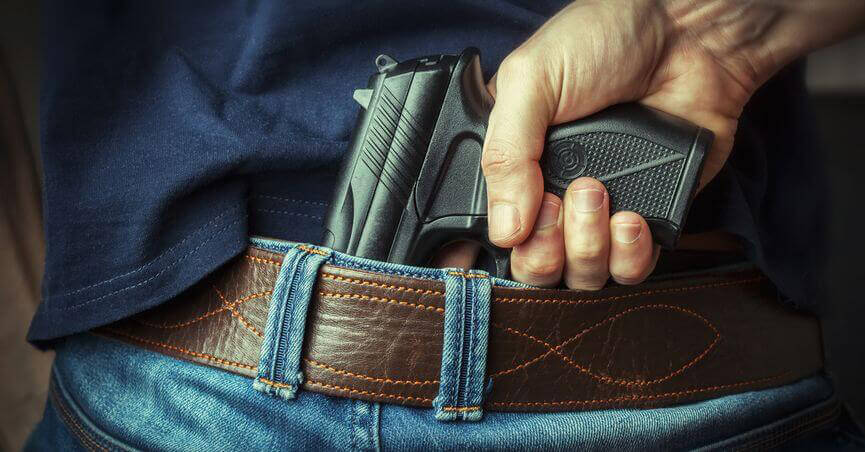
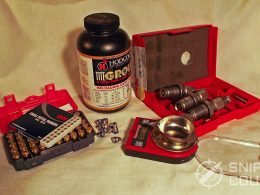
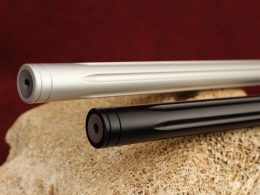
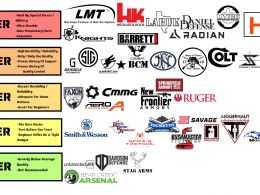
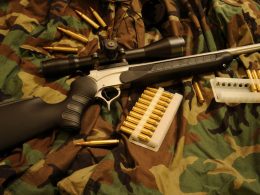
Mike, I field tested the Colt 10mm Delta Elite for Colt as a law enforcement officer when they first started production. Besides carrying it every shift on and off duty, I used it through out FBI and several other firearms instructor courses. After a year and a half with no issues what so ever I bought it. Point of Aim and Point of Impact at 100 yards was the same. I worked a remote area and having 200 grains of self protection was more than comforting. When Para-Ordinance came out with the larger frame and double stack magazines I had our Department Gun Smith put my Delta on to the Para frame. I carried that fire arm for over 20 years. I had occasion to put down two large animals that had been hit by vehicles on one of our highways. One was a mixed breed cow that had her back legs broken on impact, 200 grains at 15 feet stopped her suffering. The other was a Bull elk that had a front leg broken and was moving away as best he could, 200 grains at 60 yards put him down the round went through his heart and lodge against the inside of his upper shoulder. These were not hunting rounds, they were Winchester’s Law Enforcement rounds. Having taught and trained Law Enforcement and civilians in fire arms for over 30 years, I advocate carrying and shooting what you are comfortable with AND HAVE PRACTICED WITH EVERY DAY. GREAT ARTICLE! P.S. I am not aware of any fatality from a Law Enforcement Shooting where a round went through the perpetrator and into an innocent person.
Thanks for the kind words, and thanks for your service. The 10mm IS awesome and very versatile. As for the overpenetration, I wasn’t thinking LE so much as an over-the-top civilian commando-type who has to carry the most powerful gun out there…I’m sure you know the type!. Thanks for a very interesting reply!
It’s a pity that one of the better calibers is forgotten, the .38 Super which is one of the favorites in IPSC shooting.
Yeah, the .38 Super is one great round, but we had to draw the line somewhere. I did mention the .38 Super in another article I wrote on 9mm 1911s – it is still going strong after its introduction in 1929!
Not bad at all.
😉
Thanks!
Nice informative article. Good writing.
Thanks for the kind words!
Thanks! Appreciate it!
Mike, you got horse before the cart. In the first paragraph about the 10mm it states “The lengthened .40 is one of the more popular cartridges out there in the field now.” That is incorrect. A 10mm [AUTO] is not a lengthened .40 S&W case. First, the 10mm was developed 7 years before the 40 S&W with the parent case being the 30 Remington. The parent case of the 40 S&W is, drum roll please, the 10mm Auto. The 10mm was adopted by the FBI following the horrible 1986 Miami shootout as a more effective handgun round. However, the recoil is significant. S&W and Winchester designed a cartridge based on the reduced power load of the FBI 10mm. Enter .40 S&W.
Vern, you got me on that one. You are right. I guess my typing got ahead of my thinking on that one. The .40’s parent case is, indeed, the 10mm. All I meant by “lengthened .40” was a different way to say 10mm. I should’ve been more specific. They did start out as different cases. Sorry about the mix-up. Thanks for keeping me honest! I’ll edit that statement so that the article is correct.
It could also be called a “10mm Short”. 🙂
Sure could!
competent and very good person I understood so many things thanks to you still very good good good
Valerio, thanks for the kind words. Experience can’t be beaten as a great teacher. I’ve just been shooting many years and have discovered certain things along the way that I try to share with you. Thanks again!
Mike you are very well schoold. I am a former USMC RECON MARINE AND QUANTICO trained Scout Sniper , and Scout Sniper Instructor, and National Match Shooter,12 years active duty. My father was a 40 year MARINE , was a Raider and Recon.he fought in WWII Korea and Vietnam, and worked for Colt Firearms in Hartford.So I was trained from my childhoodat age 7 to 17 by my father about weapons ammo and reloading untill i joined the Corps at 17 yo. You are only one man that I can say knows WTF Youre talking about in a very professional manner, skilled to the hilt.Iam a lover of the .41 Mag S&W,and .40 S&W and 5 mm Mag just because of the fppsi upon impact as well as the recoil energy , aand the ability to keep my sights on a rarget .I also have my .40. Quad ported so my line of sight is maintained in a better on target position while in repedetive fire action.I also carry a govener for backup loaded with .410 slugs, due to if you are pulling a backup out its time to do major damage quickly . A .410 slug sure does that. Semper Fi to youre son as well as you sir
NR Gomez, I think you just paid me the ultimate compliment. I have known many Marines over my 60+ years, who had fought from Guadalcanal to the Middle East. I have always held a deep respect for the Corps. I take your compliment very seriously, as you have “been there and done that”. Thank you (and your father) for your service, and thanks for writing. And, since Veterans Day was yesterday, let me take the opportunity to thank ALL who have served their country – I salute you!
Mike, would like to hear your review of the 45 GAP and 357 SIg.
Kenneth, I don’t know much about the 45 GAP…I just know that it was supposed to be a .45 caliber auto cartridge that had less recoil than the .45 ACP. The overwhelming popularity of the old .45 ACP sort of put the nail in the coffin of the GAP. I think it’s still made, but I’ve never seen it on my local dealers’ shelves. As for the .357 Sig, that is a great, popular round. I just did a review of the Glock 32 in that caliber – look for it soon. The Sig round basically puts .357 Magnum ballistics in an autoloader – a 125-grain bullet at a measured (by me) 1340 fps. That’s some serious energy. I appreciate you writing – hope this helps.
Mike, I appreciate the thoroughness of your articles. Relative to the recoil figures in your chart, I have some personal observations. First, I’m disappointed the .41 magnum cartridge wasn’t included in the study. This much underappreciated cartridge is powerful, and less snappy than the .44 mag. Secondly, relative to the recoil figures in your chart, my experience in range time with the .357 mag, 9mm, .40 S&W, 10mm, and .44 Special does not conform to the figures. For example, I find full house .357 magnum loads result in much more perceived recoil than .40 S&W. Likewise, 10mm rounds have more pronounced recoil than .44 Special. Lastly, .45acp cartridges buck more than 9mm in the various pistols I own. Could this be due to cartridge powder loading or the weight of the guns used? Thanks.
John, you make some valid points, the most important of which (in my opinion) is that everybody perceives recoil differently. What recoils like a mouse gun to some folks would recoil like a moose gun to others. I tried to be objective and used published formulas to calculate recoil energy, but those are numbers on paper, not guns in the hand. The only reason I omitted the .41 Magnum is because, although it still has a following, it isn’t really considered a mainstream cartridge now. I agree that it should be considered that, but I base caliber decisions on what ammo you can find in most stores. Some places will stock .41 Mag, but it’s rather specialized. In the police world, it never took off like its originators hoped. I do like the round and agree with you, and I thank you for writing!
Hi Mike. Great article. I, too, was a bit disappointed to not find any mention of the 5.7×28, but I don’t feel so bad after realizing you left out the .41 Mag as well…
On the other hand, the title DOES use the word ‘Ultimate’ . . .
Jim, yeah, I had to limit my scope to what most consider mainline cartridges. I do love both the 5.7 and the .41. They are both good, effective rounds with loyal followings. Perhaps if I do a comprehensive round update I could include those. I appreciate you writing!
Jim, I agree that the 5.7 and .41 Mag are great cartridges – I just had to draw the line somewhere. I included mostly mainstream calibers, or at least what are thought of as mainstream. Perhaps one day I’ll do a comprehensive guide and include both of those (and a lot of others). I appreciate your comments – thanks for writing!
Wow. Stumbled upon his article by chance. So impressed! Thorough and incredibly informative. Can’t thank you enough.
Rowan, I’m glad you liked it. It’s nice to know that what I wrote is helpful. Thanks for writing!
Excellent recap of three of my favaourite cartridges.. My new 10MM 4.2″ Ruger MC is just now getting daily load testing.. I bought it for the very reason you identified. I know I can’t rapidly shoot the 44mag accurately. with useful heavy loads so the 10MM was my choice.. I live just a bit south of the Alaska panhandle and we have lots of Black and rather big Brown bears. While I also carry a 12 gauge Mossberg, the shot gun is not always beside me hence the 10MM. With the Browns it is better than throwing rocks and I’ll only get one or two shots off anyway. The bush here is [pretty thick. I’ll use 200 gr hard cast LSWC, load them hot and prey I never have to use them. Great read to day, thanks.
Bob., thanks for the kind words. I’m glad you liked it. I must admit, the only bears around the middle part of the state where I live are of the Yogi variety and are on TV, but there have been some blacks spotted further south. The 10mm ought to serve you well. Thanks for writing!
Good article. I enjoyed the brief history of each of the cartridges you highlighted. As a fellow reloader, I’ve reloaded all but the 10 mm. I’ve been looking at 1911 in 10, but ammo is so scarce right now, I’m hesitant to buy a gun I can’t find ammo for (at least not at the Scalper’s prices I’m seeing). Heck, a search for even once fired brass was a no go.
These are the cartridges that have stood the test of time, from the lowly .22 and .45 Colt the oldest to the newest the 10 mm/.40 S&W. Great job Mike.
Chuck, thanks for the kind words. I know what you mean about 10mm ammo being scarce or expensive – I have a new Springfield XDM Elite Compact in 10mm sitting in my gun safe with a review half written but can’t find any 10mm to shoot in it. Hopefully that will get better soon – we’ll see. Thanks again for writing!
Your leaving out the 357 sig is sad. Its orig design was to give near 357 magnum performance in a higher capacity and fast to reload auto pistol. I carry 10mm and 357 sig every day and trust both of them. The 357 sig is a faster choice for people that think 9mm is too low in power to trust for serious defense.